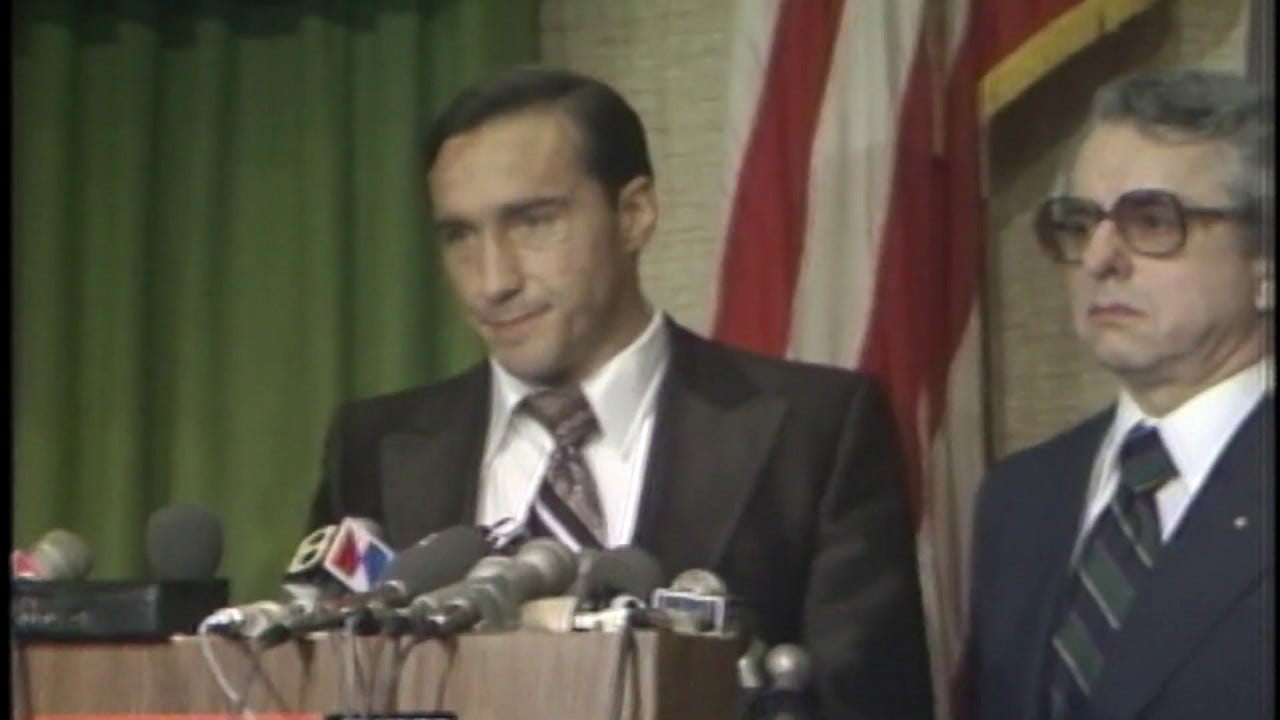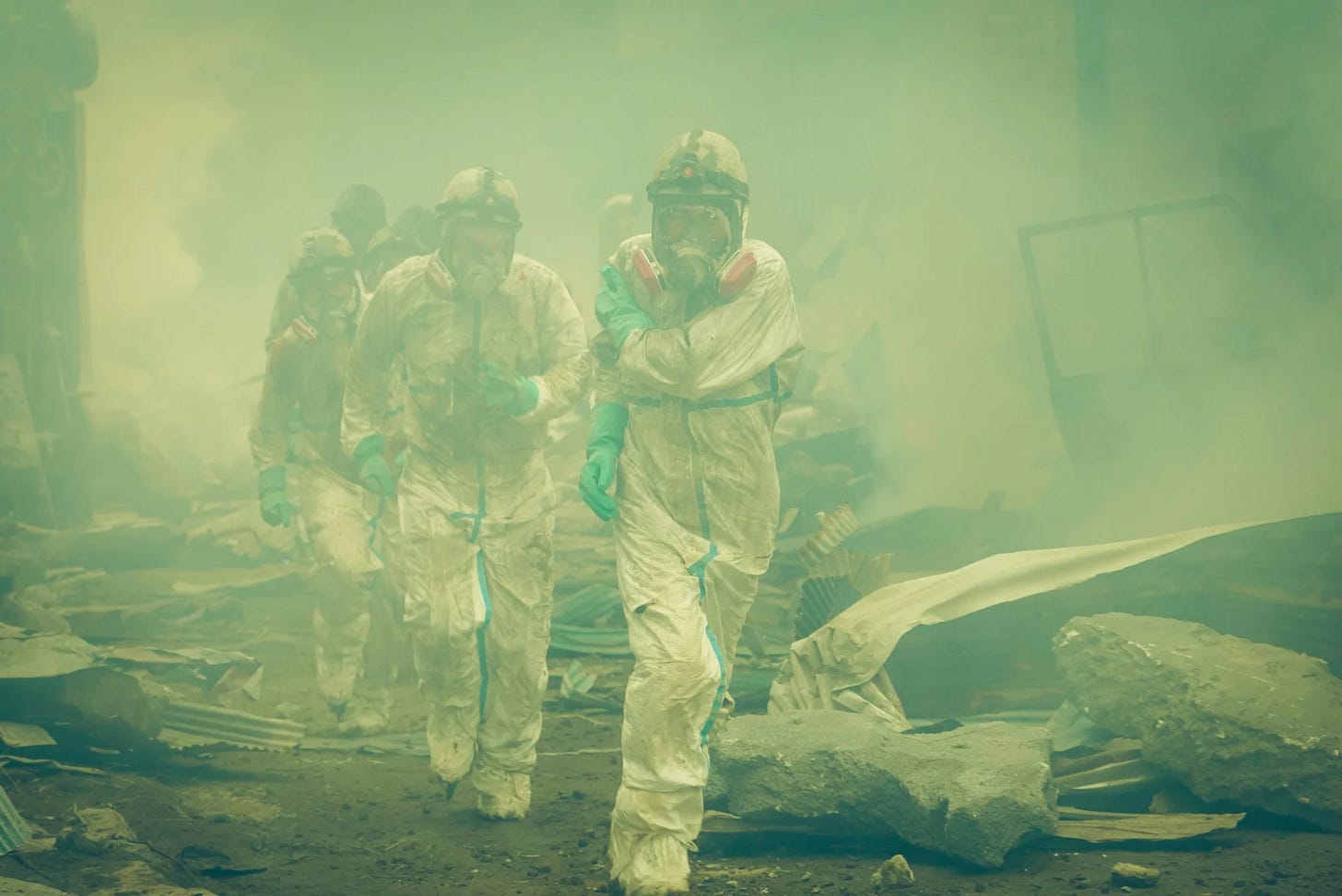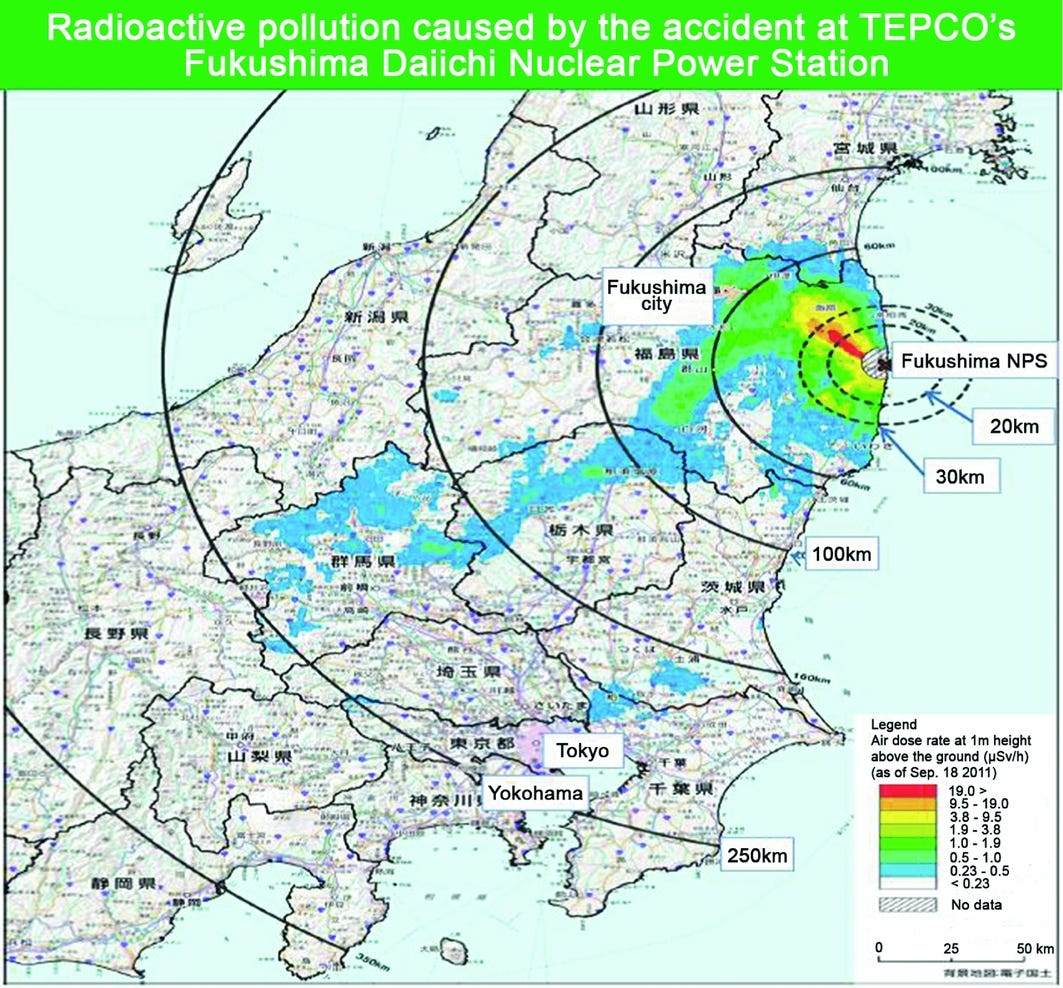Dammed Nukes
How close could Europe’s largest nuclear power station come to meltdown? What about the one in Japan?
Lately, I’ve been binge-watching The Days, Netflix’s Japanese docudrama on the Fukushima disaster told from the viewpoint of those in the control room, emergency management center, or close to the Prime Minister.
The Days is not so different from an earlier version, Fukushima 50 (2020); HBO’s Chernobyl (2019); the star-studded China Syndrome (1979), or Netflix’s 2022 Meltdown: Three Mile Island. There is the usual cast of weaselly utility toadies and PR flacks, nuclear engineers who turn out to be dumb as a post but make great, obedient cannon fodder; and frozen-in-the-headlights heads of countries who just realized they’ve been sold a pack of lies and may soon lose Pennsylvania, New York, Washington, Kyiv, Belarus, or Tokyo. One Nuke, One Nation.
Each lying utility weasel finesses the long-term damage to workers or residents who, Kamakazi-like, receive their lifetime allowed exposure to radioactivity in a 6-minute dash to turn a valve one-quarter rotation or innocently while waiting for the school bus, lunchbox in hand (“no immediate danger” is the usual euphemism uttered from the podium). In the case of Fuke, the fuel in the reactors was Plutonium mixed oxide, so the notion of a safe inhaled dose, repeated over and over to a gullible press gallery, would be laughable were it not so cruel.
How many died at Three Mile Island’s near miss? Hundreds in the downwind direction the March 29, 1979 plume traveled. Millions, if you take the lethal genetic toll into account.

Governor Thornburgh said to the President, “I would like the federal government’s recommendation as to whether or not we should go beyond the 5-mile precautionary evacuation and order a broad scale 360-degree evacuation.” (Pause) But the concern was the lasting impact on the nuclear industry.
—Jessica Tuchman Mathews (Aide to President Jimmy Carter), Meltdown: Three Mile Island.
In each of these docudramas, there is a nearly identical moment when the top mucky-mucks get the message that the so-called experts upon whom they have been relying are utterly clueless as to what is unfolding. They are poring over outdated manuals that have exactly zero information to explain the catastrophic turn of events. So it is when we pick up The New York Times and read that the largest nuclear plant in Europe is perhaps days away from catastrophic multi-reactor meltdown, a la Fukushima, we have to grumble some hackneyed phrase like history never repeating itself, until it does.
But like at Three Mile Island, which came within 30 minutes of blowing its pressure vessel a la Fuke, Zaporizhzhia has the good fortune to have a reserve source of water.
If you just fell off the turnip wagon, the story is this. Somebody planted a bomb in the turbine room under the Kakhovka hydro dam at Kryviy Rih, Ukraine. Russia, in whose military zone the heavily fortified river crossing lies, says it was Ukrainian saboteurs, and the motive was to cut the water and power supply to Crimea. Ukraine says it was Russia and that story would seem to make more sense since Ukraine was advancing to cut off access to Crimea and the dam provided a direct route across the Dnipro River for its army. Blowing the dam stopped the Ukrainian advance at the water’s edge. The officer who ordered that could be in line for a commendation directly from Vladimirovich.
As billions of gallons flow through the rupture, residents of towns and cities below the dam are frantically evacuating anyone who has not already been swept away. Upstream, whoever blew up the dam apparently failed to recognize that the dam held back a reservoir the size of the Great Salt Lake that had a second important task. That lake was responsible for cooling the Zaporizhzhia Nuclear Power Plant. Even in shutdown mode, Zaporizhzhia’s fuel rods have to be continuously cooled for three to eight years before they can be removed off-site or to dry cask. Anything short of that, well… Fukushima.
Bless you.
The first reports had the lake level dropping two to three inches per hour. If so, it could be only a few days before water levels drop below the intake pipes for the reactors.
The IAEA convened an emergency meeting and determined that fortunately, a dam failure was among the scenarios considered in the design plan. In the event of such a catastrophe, the plant can still draw water from a large cooling pond on the grounds and that pond can be refilled from the Dnipro, or from groundwater wells if the reservoir has drained.
Seldom are plans perfect, as they discovered in the Control Room of Three Mile Island when a valve that should have closed stayed stuck open, or at Fukushima when a tsunami that should only have been three meters high was nine meters and flooded the backup power generators. What might they be missing now, at Zaporizhzhia?
What comes to my mind is the weather. Last summer, the water flow in the Dnipro basin decreased 24 percent in the heat of summer, in a (cooler) La Niña year. In 2020, the water level in the Desna tributary upstream reached its lowest point in 140 years of observations—5 meters below normal. Of course, last summer wasn’t just dry for Ukraine. France’s longest river, the Loire, could be crossed on foot. The Rhine became impassable to barge traffic. The Po dropped six feet. Serbia had to dredge the Danube. Even though Europe was experiencing a war-related energy crisis that jacked up electric bills, the Garonne, Rhône and Loire rivers became too warm to allow cooling water to be discharged so nukes had to shut down. The French simply allowed five plants to break the rules. Gee, that sounds a lot like the movies.
The announcement this week from Japan's Nuclear Regulation Authority (NRA) of a looming potential collapse at Unit 1 of Fukushima Daiichi due to stress failure of the concrete pedestal and the molten core reaching groundwater—events that could result in the loss of one-third of Japan—is reminiscent of The China Syndrome.
I could say the lesson here is never to build a nuclear plant anywhere you are planning to have a war, but that is too rosy. You should never build one, period, and should be retiring those still operating. If you think I am being hyperbolic, binge-watch those films and see if you see a pattern.
Meanwhile, let’s end this war. Towns, villages, and cities in Ukraine are being bombed every day. Ecovillages and permaculture farms have organized something like an underground railroad to shelter families fleeing the cities, either on a long-term basis or temporarily, as people wait for the best moments to cross the border to a safer place, or to return to their homes if that becomes possible. There are 70 sites in Ukraine and 500 around the region. As you read this, we are sheltering some 2,000 adults and 450 children. We call our project “The Green Road.”
For most of the children refugees, this will be their first experience in ecovillage living. They will directly experience its wonders, skills, and safety. They may never want to go back. Those that do will carry the seeds within them of the better world they glimpsed through the eyes of a child.
Those wishing to make a tax-deductible gift can do so through Global Village Institute by going to http://PayPal.me/greenroad2022 or by directing donations to greenroad@thefarm.org.
There is more info on the Global Village Institute website at https://www.gvix.org/greenroad or read this recent article in Mother Jones. Thank you for your help.
The COVID-19 pandemic destroyed lives, livelihoods, and economies. But it has not slowed climate change, a juggernaut threat to all life, humans included. We had a trial run at emergency problem-solving on a global scale with COVID — and we failed. 6.88 million people, and counting, have died. We ignored well-laid plans to isolate and contact trace early cases; overloaded our ICUs; parked morgue trucks on the streets; incinerated bodies until the smoke obscured our cities as much as the raging wildfires. The modern world took a masterclass in how abysmally, unbelievably, shockingly bad we could fail, despite our amazing science, vast wealth, and singular talents as a species.
Having failed so dramatically, so convincingly, with such breathtaking ineptitude, do we imagine we will now do better with climate? Having demonstrated such extreme disorientation in the face of a few simple strands of RNA, do we imagine we can call upon some magic power that will arrest all our planetary-ecosystem-destroying activities?
As the world emerges into pandemic recovery (maybe), there is growing recognition that we must learn to do better. We must chart a pathway to a new carbon economy that goes beyond zero emissions and runs the industrial carbon cycle backward — taking CO2 from the atmosphere and ocean, turning it into coal and oil, and burying it in the ground. The triple bottom line of this new economy is antifragility, regeneration, and resilience. We must lead by good examples; carrots, not sticks; ecovillages, not carbon indulgences. We must attract a broad swath of people to this work by honoring it, rewarding it, and making it fun. That is our challenge now.
Help me get my blog posted every week. All Patreon donations and Blogger or Substack subscriptions are needed and welcomed. You are how we make this happen. Your contributions are being made to Global Village Institute, a tax-deductible 501(c)(3) charity. PowerUp! donors on Patreon get an autographed book off each first press run. Please help if you can.
#RestorationGeneration
Thank you for reading The Great Change.










